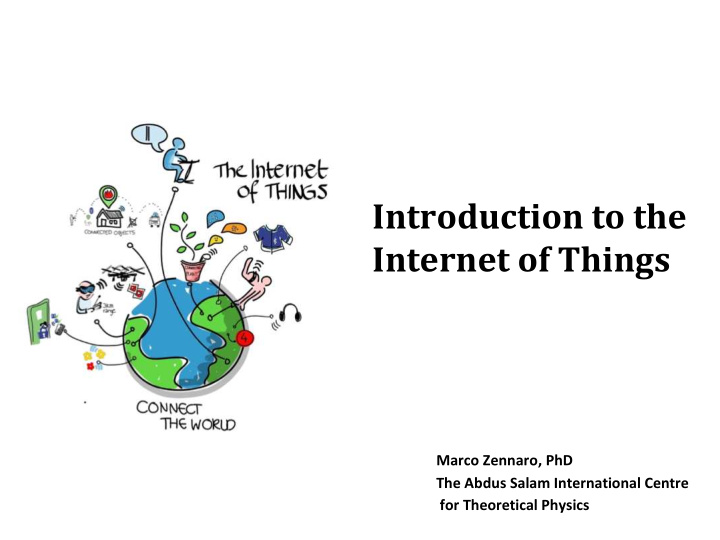



Introduction to the Internet of Things Marco Zennaro, PhD The Abdus Salam International Centre for Theoretical Physics
Vision
History of IoT • The first telemetry system was rolled out in Chicago way back in 1912 . It is said to have used telephone lines to monitor data from power plants. Source: https://cdn2.hubspot.net/hub/246745/file-67175098-pdf/History_of_M2M_Infographic.pdf
History of IoT • Telemetry expanded to weather monitoring in the 1930s, when a device known as a radiosonde became widely used to monitor weather conditions from balloons.
History of IoT • In 1957 the Soviet Union launched Sputnik, and with it the Space Race. This has been the entry of aerospace telemetry that created the basis of our global satellite communications today.
History of IoT • Broad adoption of M2M technology began in the 1980s with wired connections for SCADA (supervisory control and data acquisition) on the factory floor and in home and business security systems. • In the 1990s, M2M began moving toward wireless technologies. ADEMCO built their own private radio network to address intrusion and smoke detection because budding cellular connectivity was too expensive. • In 1995, Siemens introduced the first cellular module built for M2M.
History of IoT
Why IoT now? • Ubiquitous Connectivity • Widespread Adoption of IP • Computing Economics • Miniaturization • Advances in Data Analytics • Rise of Cloud Computing
RPi Zero: $5
IoT Definition
ITU Definition “The IoT can be viewed as a global infrastructure for the information society, enabling advanced services by interconnecting (physical and virtual) things based on existing and evolving interoperable information and communication technologies (ICT).” Source: Recommendation ITU-T Y.2060
Things • Physical things exist in the physical world and are capable of being sensed, actuated and connected. Examples of physical things include the surrounding environment, industrial robots, goods and electrical equipment. • Virtual things exist in the information world and are capable of being stored, processed and accessed. Examples of virtual things include multimedia content and application software. Source: Recommendation ITU-T Y.2060
ITU Definition Source: Recommendation ITU-T Y.2060
ITU Definition A device is a piece of equipment with the mandatory capabilities of communication and optional capabilities of sensing, actuation, data capture, data storage and data processing . The devices collect various kinds of information and provide it to the information and communication networks for further processing. Some devices also execute operations based on information received from the information and communication networks. Source: Recommendation ITU-T Y.2060
Fundamental characteristics • Interconnectivity : With regard to the IoT, anything can be interconnected with the global information and communication infrastructure. • Heterogeneity : The devices in the IoT are heterogeneous as based on different hardware platforms and networks. They can interact with other devices or service platforms through different networks. • Dynamic changes : The state of devices change dynamically, e.g., sleeping and waking up, connected and/or disconnected as well as the context of devices including location and speed. Moreover, the number of devices can change dynamically. Source: Recommendation ITU-T Y.2060
Fundamental characteristics • Enormous scale : The number of devices that need to be managed and that communicate with each other will be at least an order of magnitude larger than the devices connected to the current Internet. The ratio of communication triggered by devices as compared to communication triggered by humans will noticeably shift towards device- triggered communication. Source: Recommendation ITU-T Y.2060
Predictions Source: Cisco IBSG, April 2011
Predictions
Predictions Source: http://www.postscapes.com/what-exactly-is-the-internet-of-things-infographic/
Internet of Fewer Things http://spectrum.ieee.org/telecom/internet/the-internet-of-fewer-things
Internet of Fewer Things http://spectrum.ieee.org/telecom/internet/the-internet-of-fewer-things
Network Connectivity Key aspects when considering network connectivity: • Range - are you deploying to a single office floor or an entire city? • Data Rate - how much bandwidth do you require? How often does your data change? • Power - is your sensor running on mains or battery? • Frequency - have you considered channel blocking and signal interference? • Security - will your sensors be supporting mission critical applications?
Network Connectivity Source: http://www.postscapes.com/what-exactly-is-the-internet-of-things-infographic/
Network Connectivity
IPv6 Smart Objects will add tens of billions of additional devices There is no scope for IPv4 to support Smart Object Networks IPv6 is the only viable way forward Solution to address exhaustion Stateless Auto-configuration thanks to Neighbor Discovery Protocol Each embedded node can be individually addressed/accessed
Connectivity Landscape
Sensors Source: http://www.postscapes.com/what-exactly-is-the-internet-of-things-infographic/
Sensors
Applications
Predictions
Predictions
Predictions
Applications
Predictions
IoT Landscape
Thank You
Recommend
More recommend